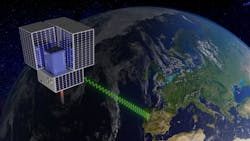The future of small satellite transfer orbits
COLOGNE, Germany - The German Aerospace Center (Deutsches Zentrum für Luft- und Raumfahrt; DLR) is currently working with UARX Space to develop a specialized spacecraft that will transport multiple satellites to different desired orbits after separation from the launch vehicle. DLR is providing a radio platform called Generic Software Defined Radio (GSDR), which is used to communicate with the ground station. GSDR is a multifunctional radio system that allows multiple applications to performed in different frequency bands. The hardware does not have to be adapted to the application-specific requirements, as is usually the case, but can be reconfigured via software and commands while in orbit, the DLR reports. Continue reading original article.
The Military & Aerospace Electronics take:
Date goes Here - In commercial spaceflight, DLR says one launch vehicle typically delivers several satellites into the same fixed target orbit to save costs. As a result, certain users must wait a long time for a launch vehicle that will fly to their target orbit or face the prohibitive cost of booking a rocket for their sole use. The Orbit Solutions to Simplify Injection and Exploration (OSSIE) orbit transfer vehicle from UARX Space is being developed with the aim of carrying satellites deployed in space to their desired target orbit, regardless of the initial deployment orbit of the launch vehicle. This places considerable demands on communication between the spacecraft and the ground segment, as the radio communication distance varies greatly throughout the mission.
The GSDR, developed by DLR, will be used as the communication subsystem, as this innovative radio platform is ideally suited to OSSIE's needs and can respond flexibly to the varying communication requirements. "After more than five years of development and extensive testing, our GSDR has now reached a technology readiness level (TRL) of 7. The next step is to demonstrate the system in orbit. We are delighted that our system will contribute to UARX's mission and help us harness OSSIE's full potential," says Jan Budroweit, Project Manager at DLR.
Related: German Space Agency selects Lockheed Martin ISpace system for situational awareness
Related: The German Aerospace Center (DLR) researches flexible wing surfaces
Related: Lufthansa Consulting and German Aerospace Center agree to strategic innovation partnership
Jamie Whitney, Associate Editor
Military + Aerospace Electronics
